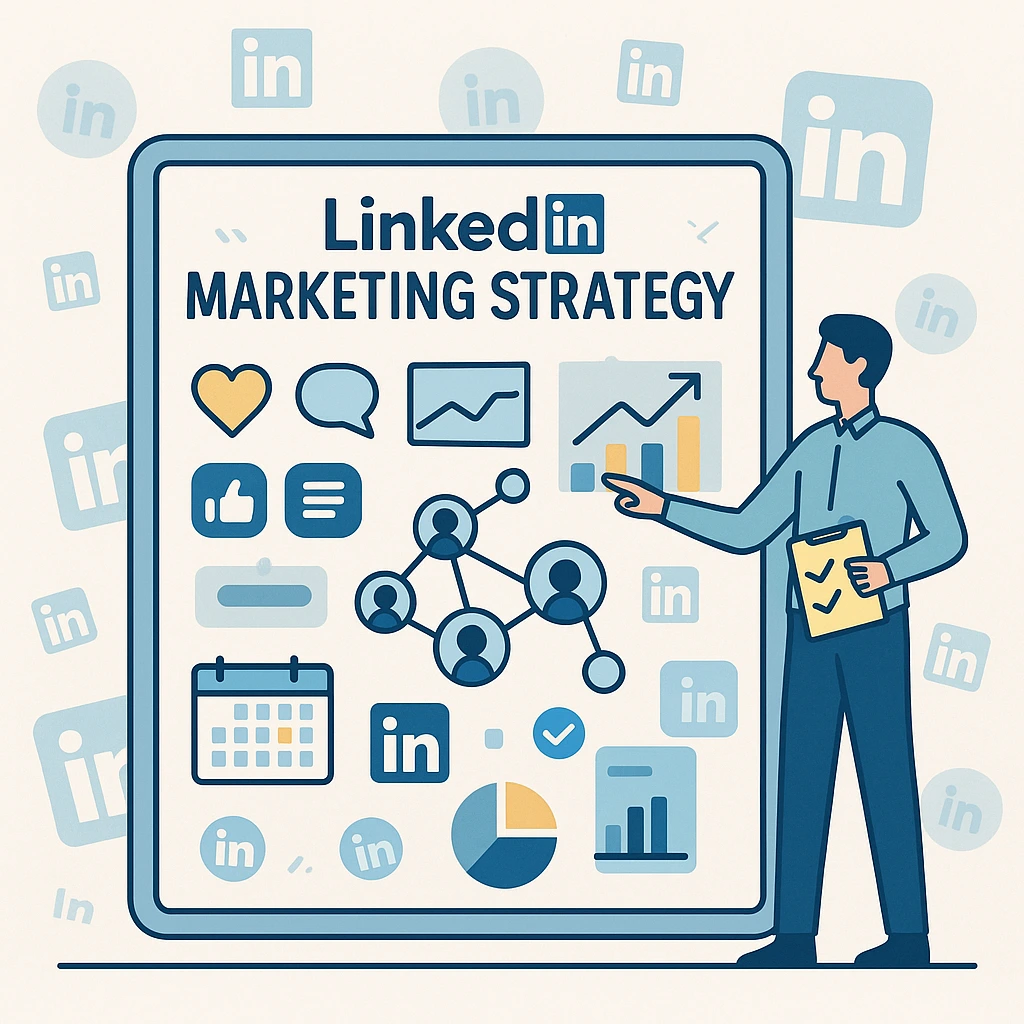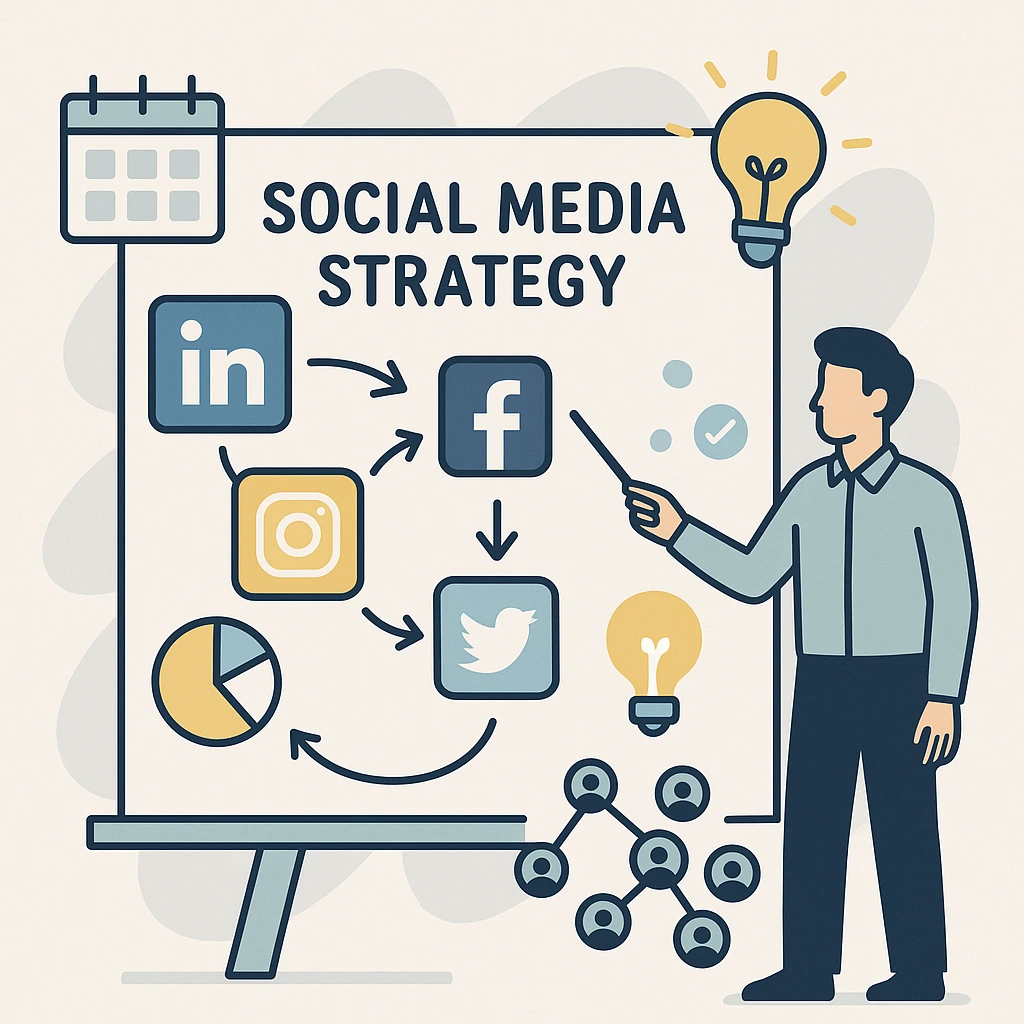LinkedIn is not just another social media platform; it’s a professional networking site designed for business professionals. With over 700 million users globally, it provides a unique opportunity to connect with industry leaders, potential clients, and collaborators. This article will guide you through effective LinkedIn marketing strategies, focusing on how to optimize your social media presence for maximum impact.

Why LinkedIn Matters?
LinkedIn’s significance lies in its ability to:
- Showcase Professional Expertise: By sharing your achievements, skills, and experiences, LinkedIn allows you to establish credibility in your field. This can be crucial for career advancement and opportunities.
- Network with Industry Leaders: The platform enables you to connect with influential figures who can have a substantial impact on your career or business. Building relationships with these leaders can open doors to new opportunities and collaborations.
- Generate Leads: LinkedIn is a powerful tool for finding potential customers and partners. By engaging with relevant content and participating in industry discussions, you can attract leads organically.
- Enhance Brand Visibility: Regular updates and posts can significantly increase your brand’s reach. By consistently sharing valuable content, you can keep your audience engaged and informed.
The Unique Landscape of LinkedIn
Understanding the unique landscape of LinkedIn is essential for leveraging its full potential:
- Professional Focus: Unlike other social media platforms, LinkedIn is primarily focused on professional interactions and business growth. This makes it an ideal space for B2B marketing and professional networking.
- Diverse User Base: With users ranging from entry-level professionals to C-suite executives, LinkedIn offers a diverse audience. Tailoring your content to different segments can enhance engagement.
- Algorithm Dynamics: LinkedIn’s algorithm prioritizes content from users with whom you have interacted. Therefore, regular engagement with your network can increase the visibility of your posts.
Aligning LinkedIn with Business Goals
To fully benefit from LinkedIn, align your strategy with your broader business objectives:
- Strategic Planning: Develop a clear plan that outlines how LinkedIn will contribute to your business goals. This could include increasing brand awareness, generating leads, or enhancing customer engagement.
- Resource Allocation: Allocate the necessary resources, including time and budget, to implement your LinkedIn strategy effectively. This ensures consistent and impactful presence.
- Measuring Success: Establish key performance indicators (KPIs) to measure the success of your LinkedIn efforts. Regularly review these metrics to adjust your strategy as needed.
Crafting an Effective LinkedIn Marketing Strategy

A well-thought-out LinkedIn marketing strategy can help you stand out in a crowded marketplace. Here’s how you can develop one:
1. Optimize Your Profile
Your LinkedIn profile is often the first impression you make. Ensure it is complete and professional. Here are some tips:
- Professional Photo: A high-quality, professional-looking photo can significantly impact how you’re perceived. Invest in a professional photo shoot if necessary to ensure your image aligns with your personal brand.
- Compelling Headline: Your headline should encapsulate your expertise and the unique value you offer. It should be crafted to attract attention and invite people to learn more about you.
- Detailed Summary: The summary section is your opportunity to tell your story. Highlight your achievements, skills, and what sets you apart from others in your field. Be concise yet comprehensive.
- Experience and Skills: Clearly list your relevant work experiences and skills. Encourage colleagues to endorse your skills, as this adds credibility and validates your expertise.
2. Build a Strong Network
Networking is at the heart of LinkedIn. Focus on building quality connections rather than just increasing numbers.
- Connect with Purpose: When sending connection requests, always personalize your message. Explain why you want to connect and how it could be mutually beneficial.
- Engage with Content: Regularly like, comment, and share posts to engage with your network. This not only keeps you visible but also strengthens your relationships with connections.
- Join Relevant Groups: Participate in groups related to your industry to expand your network and gain insights. Engaging in discussions can position you as a thought leader.
3. Create and Share Valuable Content
To maintain visibility, you need to be active on LinkedIn. Share content that is relevant to your audience.
- Publish Articles: Writing articles allows you to showcase your expertise and insights. Aim to address common challenges or trends in your industry to attract a wider audience.
- Post Regular Updates: Keep your network informed by sharing news, achievements, and industry updates. Regular posting keeps you top-of-mind for your connections. Tools like Linkify simplify this by crafting posts that sound like you, helping you stay visible, build trust, and engage your audience without spending hours on content creation.
- Use Visuals: Incorporate images, infographics, and videos to make your posts more engaging. Visual content often receives higher engagement rates.
4. Utilize LinkedIn Features
LinkedIn offers various features that can enhance your marketing efforts.
- LinkedIn Ads: Use targeted ads to reach a specific audience. This can be particularly effective for promoting events or specific offerings.
- InMail: Send personalized messages to connect with potential clients. Craft messages that are direct, concise, and tailored to the recipient’s interests.
- Analytics: Use LinkedIn analytics to track the performance of your posts and adjust your strategy accordingly. Analyzing data can provide insights into what resonates with your audience.
Implementing a Social Media Strategy and Optimization
A comprehensive social media strategy incorporates multiple elements to ensure success.

1. Set Clear Goals
Define what you want to achieve with your LinkedIn strategy. Whether it’s increasing brand awareness, generating leads, or establishing thought leadership, having clear goals will guide your actions.
- Identify Objectives: Clearly define your primary objectives for using LinkedIn. This could range from expanding your professional network to driving traffic to your website.
- Align with Business Strategy: Ensure that your LinkedIn goals align with your overall business strategy. This alignment helps in creating a cohesive marketing approach.
- Track Progress: Regularly monitor your progress towards achieving these goals. Use analytics tools to assess performance and make informed decisions.
2. Consistent Branding
Ensure your LinkedIn presence is consistent with your overall brand image. Use the same logos, color schemes, and messaging as your other marketing channels.
- Visual Consistency: Maintain a consistent visual identity across your LinkedIn profile and posts. This includes using the same logos, color schemes, and design elements as other marketing materials.
- Messaging Coherence: Ensure that the tone and messaging on LinkedIn align with your brand’s voice. Consistency in messaging reinforces brand recognition.
- Brand Storytelling: Use LinkedIn to tell your brand story in a way that resonates with your audience. Share experiences and milestones that highlight your brand’s journey.
3. Monitor and Adjust
Regularly review your strategy’s effectiveness. Use LinkedIn analytics to see what works and what doesn’t. Be prepared to adjust your approach based on data and feedback.
- Data Analysis: Regularly analyze your LinkedIn data to understand what content performs best. This can guide future content creation and strategy adjustments.
- Feedback Integration: Pay attention to feedback from your audience and make necessary changes. Engaging with comments and messages can provide valuable insights.
- Continuous Improvement: View your LinkedIn strategy as a dynamic process. Continuously seek ways to improve and adapt to changing trends and audience preferences.
4. Foster Engagement
Engagement is key to a successful LinkedIn strategy. Encourage your audience to interact with your content by asking questions, starting discussions, and responding to comments.
- Interactive Content: Create content that invites interaction. This could be through polls, Q&A sessions, or discussion posts.
- Responsive Communication: Be proactive in responding to comments and messages. Prompt responses show that you value your audience’s input and encourage further interaction.
- Community Building: Focus on building a community around your LinkedIn presence. Engage regularly with your audience to foster a sense of belonging and loyalty.
Real-Life Examples of Effective LinkedIn Marketing
Several brands and professionals have successfully harnessed the power of LinkedIn. Here are a couple of examples:
Case Study: IBM
IBM uses LinkedIn to showcase its thought leadership by regularly sharing articles on technology trends and innovations. They engage with their audience through insightful content and discussions, positioning themselves as industry leaders.
- Content Strategy: IBM’s content strategy focuses on sharing cutting-edge insights and research, positioning them as pioneers in technology.
- Audience Engagement: By fostering discussions around their content, IBM effectively engages with their audience, encouraging them to share their own perspectives.
- Thought Leadership: Through consistent, high-quality content, IBM has established itself as a thought leader, attracting a following of professionals interested in technology advancements.
Case Study: Mary Smith, Career Coach
Mary Smith, a career coach, uses LinkedIn to connect with professionals seeking career advice. By sharing success stories and tips, she has built a strong personal brand and attracted new clients.
- Personal Branding: Mary has developed a compelling personal brand by consistently sharing valuable career advice and insights.
- Client Engagement: Through interactive posts and personalized advice, she engages directly with her audience, building trust and credibility.
- Lead Generation: By showcasing her expertise and success stories, Mary has effectively attracted new clients seeking her coaching services.
Conclusion
Maximizing your LinkedIn presence involves a strategic approach to networking, content creation, and engagement. By optimizing your profile, building a strong network, and leveraging LinkedIn’s features, you can enhance your brand visibility, connect with key industry players, and achieve your business objectives.
Whether you’re a small business owner, a startup founder, or a marketing manager, implementing these strategies can lead to significant growth and success on LinkedIn. Remember, consistency and engagement are key to unlocking the full potential of this powerful platform.
- Strategic Implementation: Take a strategic approach to LinkedIn, aligning your activities with your overall business goals for maximum impact.
- Continuous Engagement: Regularly engage with your network to maintain visibility and build lasting relationships.
- Adaptation and Growth: Be prepared to adapt your strategy based on feedback and data insights, ensuring continuous growth and success on LinkedIn.
